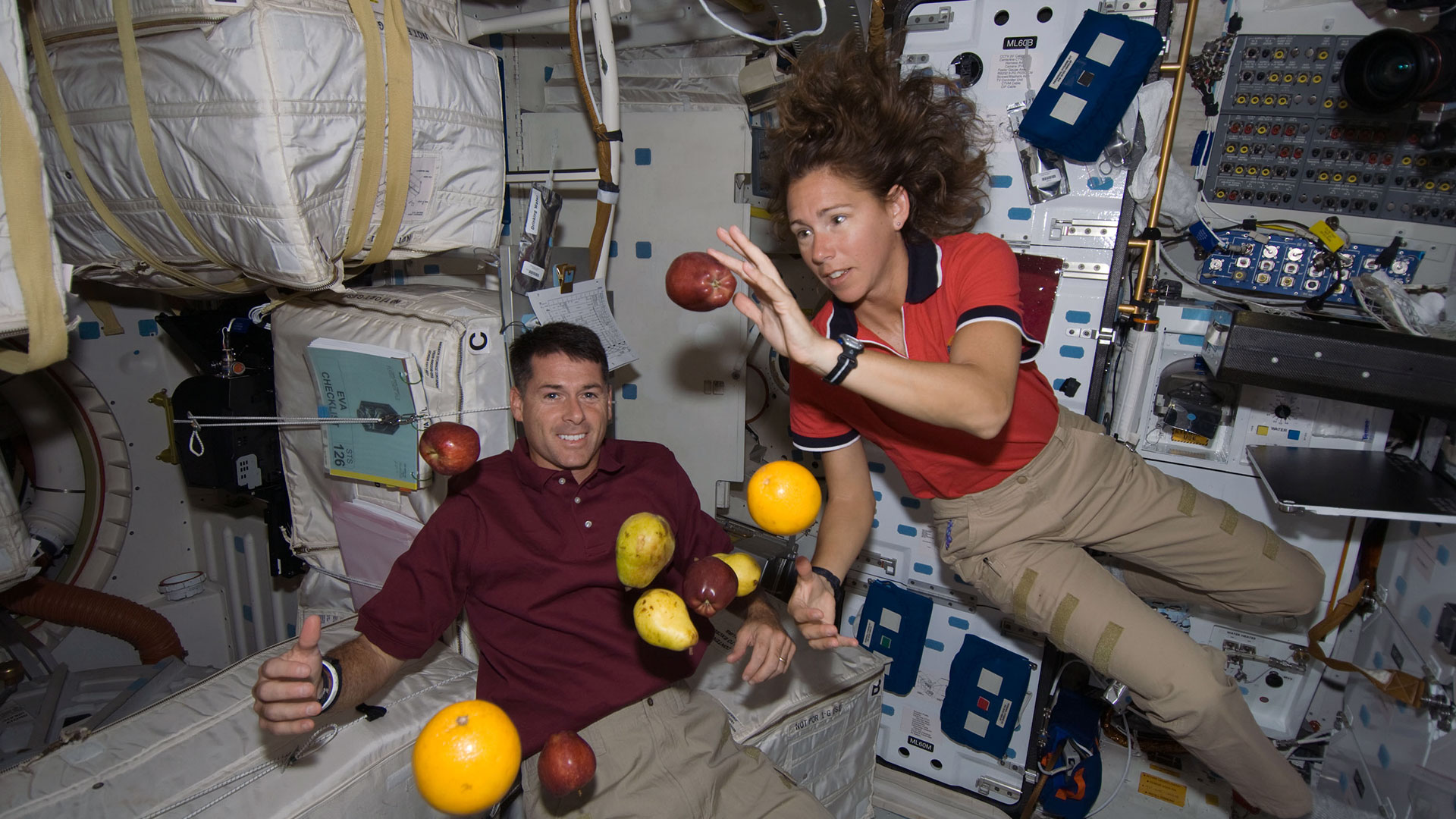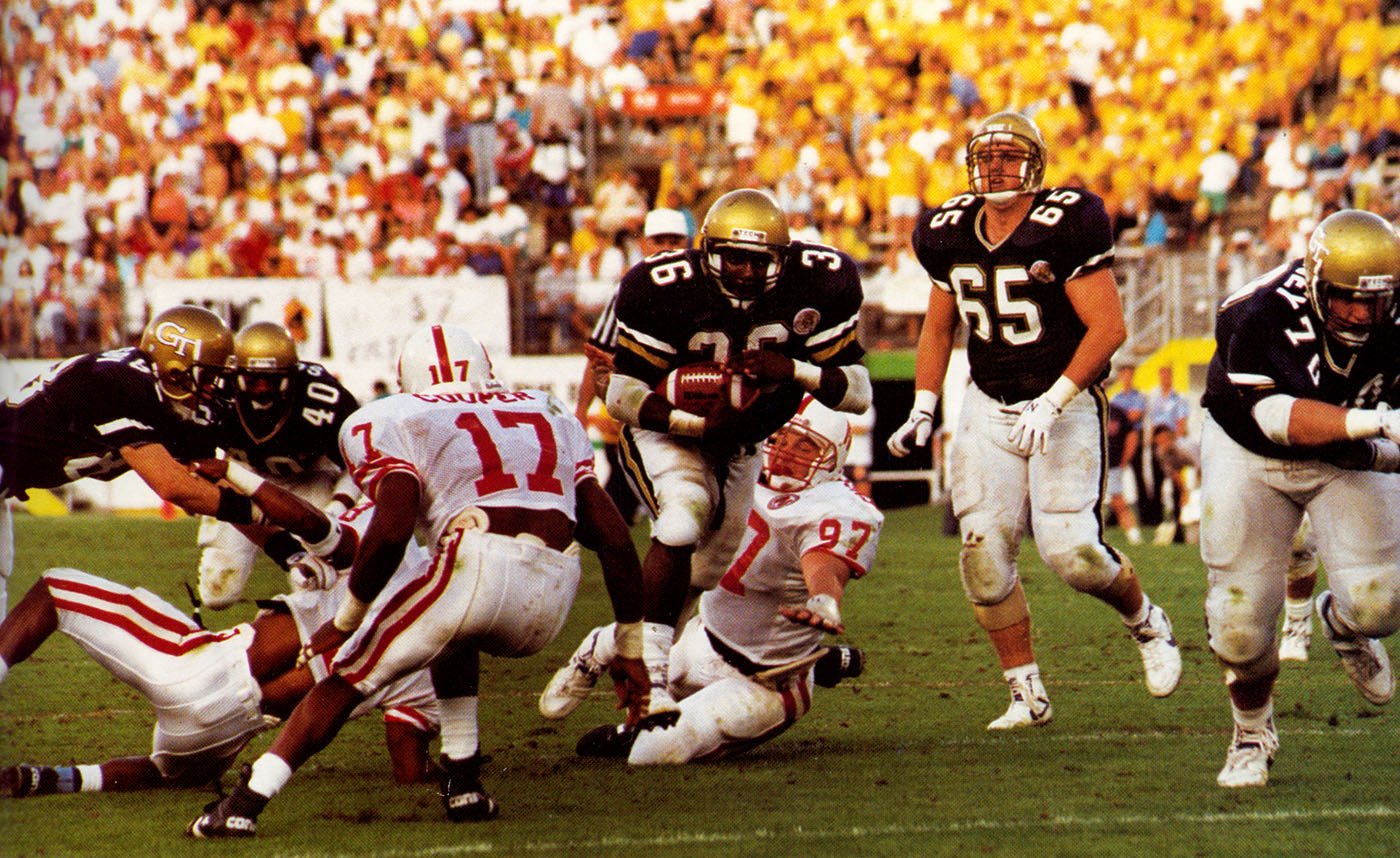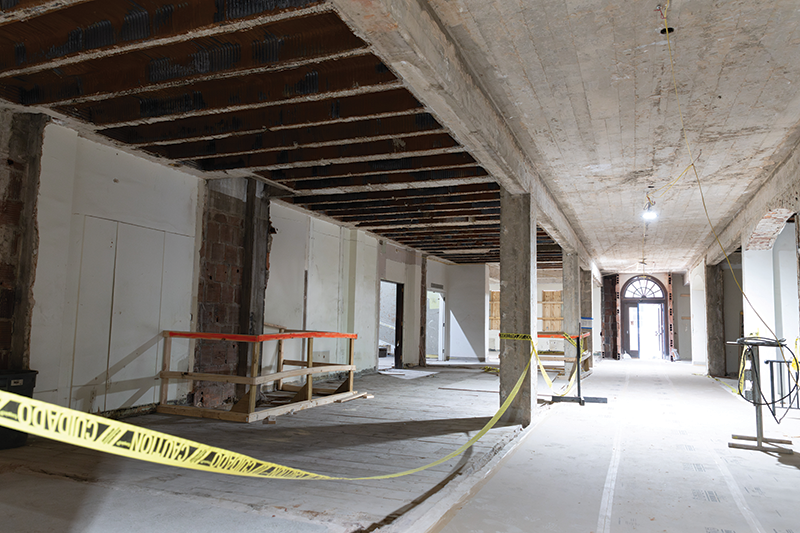Big Adventure: Remembering the Ramblin' Raft Race
By: Kristin Baird Rattini | Categories: Tech History
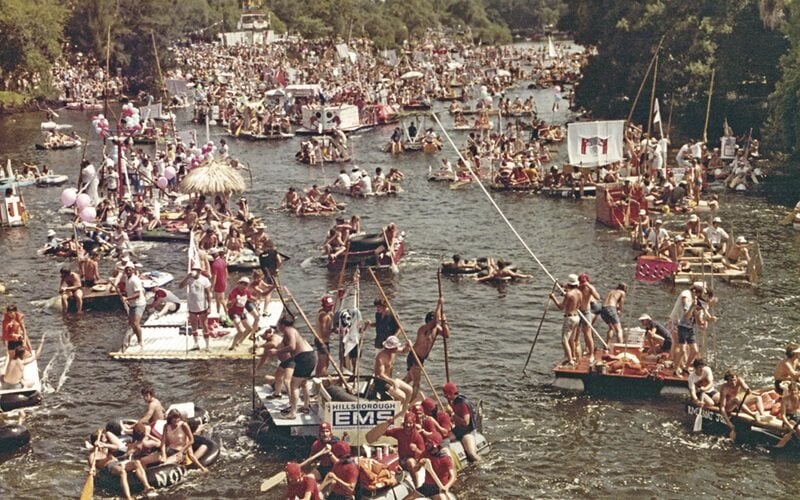
It was dubbed “Woodstock on the Water” and “The Rose Bowl on the River.” But the event that drew hundreds of thousands of people to a 9.2-mile stretch of the Chattahoochee River north of Atlanta every third Saturday of May in the 1970s was better known as the Ramblin’ Raft Race.
Larry Patrick, Text 73, the race’s larger-than-life founder, preferred to think of this immense floating party (the country’s biggest) as “the greatest adventure since the ark.” That crazy adventure, run by Tech students and alumni, lives on in the memories of countless Tech graduates and changed the course of the Hooch’s history.
From Whim to Spectacle
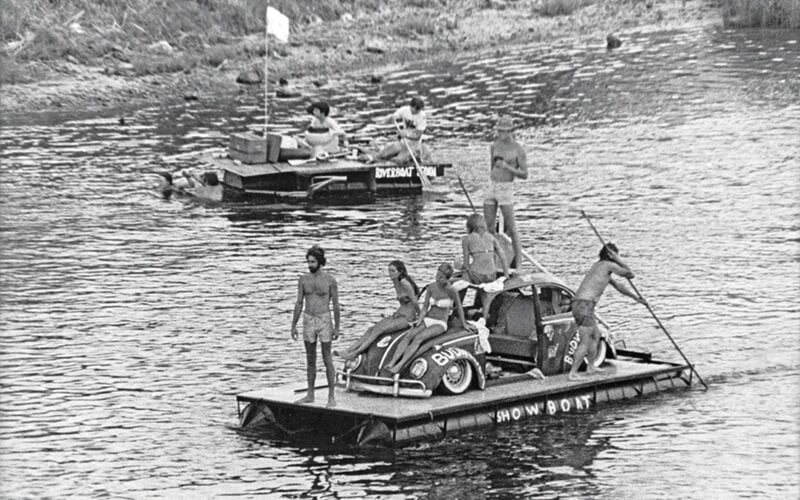
Just how grand of a spectacle was the Ramblin’ Raft Race? In 1978, Guinness World Records declared it the largest participatory sporting event in the world. The next year, the race hit its peak, with more than 400,000 spectators and 70,000 participants floating on inner tubes or on wildly creative contraptions of varying degrees of seaworthiness. “The number of people was incredible,” says Deborah Staudinger, CE 78. “It was a day for young people in Atlanta from every walk of life to have fun on the river. Everyone was welcome.”
This juggernaut started a decade earlier on a whim, really, something fun that Patrick dreamed up to do with his Delta Sigma Phi fraternity brothers who were bored on campus during the summer of 1969. He called WQXI radio station and challenged the DJs, on the air, to a raft race on the Chattahoochee. More than 50 participants and around 2,500 spectators showed up for the inaugural event in July 1969, a grueling 34-mile race that lasted about 30 hours.
“Nobody quit talking about it,” Larry Patrick said in a Living History interview in 2013, two years before his death. “You started to hear, ‘Next year, next year.’” Patrick recognized the potential to make the race something bigger—much, much bigger.
“Larry was a combination of P.T. Barnum and Walt Disney,” says Gil Patrick, Text 77, his younger brother and right-hand man on running the race. “He was full of imaginative, grandiose ideas and plans and a true showman.” Gil was widely regarded as the Roy Disney to Larry’s Walt, the man who made the dreams a reality. “Larry was the visionary; Gilbert was the backbone,” says Mike Knaszak, ME 81. “Gilbert made it work.”
Laying the Foundation for "This Insane Race"
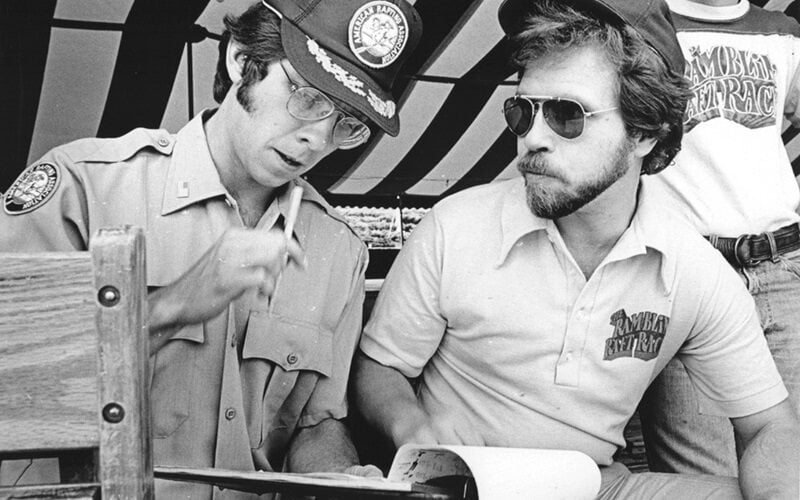 The 1970 race set the template, tone, and momentum for nearly all that followed. A new, much-shorter course ran 9.2 miles from below the Morgan Falls Dam to Paces Ferry, providing spectators an easier route to gather along. In addition to WQXI as a race partner, the Coca-Cola Company signed on as one of the first of what would become many corporate sponsors. New race classes were created for homemade rafts to encourage creativity, if not necessarily engineering prowess. And while the event was technically a race, it was truly all about fun. Even the paddle awarded to winners in later years acknowledged it, congratulating victors for the “bravery, perseverance, sportsmanship, and whatever else
The 1970 race set the template, tone, and momentum for nearly all that followed. A new, much-shorter course ran 9.2 miles from below the Morgan Falls Dam to Paces Ferry, providing spectators an easier route to gather along. In addition to WQXI as a race partner, the Coca-Cola Company signed on as one of the first of what would become many corporate sponsors. New race classes were created for homemade rafts to encourage creativity, if not necessarily engineering prowess. And while the event was technically a race, it was truly all about fun. Even the paddle awarded to winners in later years acknowledged it, congratulating victors for the “bravery, perseverance, sportsmanship, and whatever else
was needed to win this insane race.”
Larry’s fraternity brothers fully embraced that philosophy of fun. Delta Sigma Phi’s raft in 1970 was The Chattahoochee Queen, a 34-foot-long tri-deck pirate ship that was beautiful in form but short on function; it sank 2 miles shy of the finish line.
Larry assigned Ron Edwards, IM 70, and other fraternity brothers to fire a pair of cannons—one homemade, one on loan from a confederate Civil War reenactor group—from opposite bluffs 150 feet above the river to greet the 1,066 rafts with showers of confetti.
Edwards and his two co-gunners on the Civil War cannon, all decked out in pirate garb, wanted a much bigger bang for their efforts. So they increased the powder and added a softball-sized wad of wet newspaper on top of dry paper to capture and compress the sound.
“As the next group of rafters rounded the bend, we fired ‘ol’ Betsy,’” Edwards remembers. “The roar of the cannon was indeed louder, and its concussion resonated strongly across the waters. But most surprisingly and terrifying to both cannon crew and rafters was the sight of an approximately two-pound wad of paper flying across the river at great speed and impacting the far-side bank. The cannon crew had just created the greatest spitball of all time.
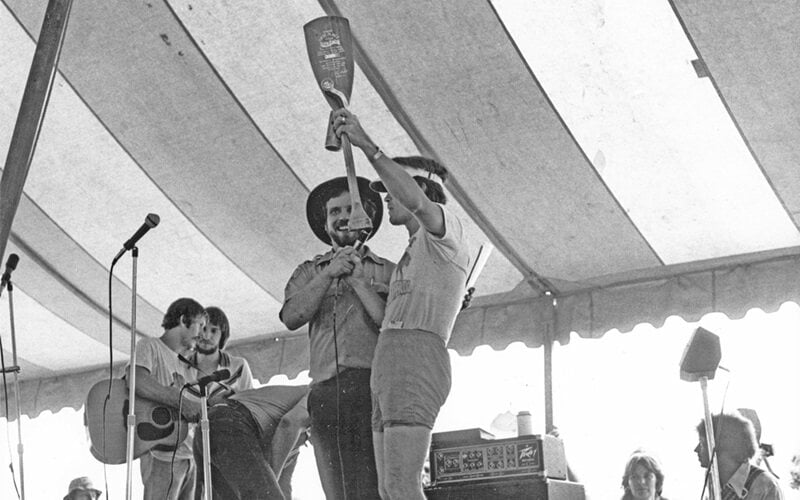
All Hands on Deck
An event of such magnitude required as many hands on deck as possible. Over the years, Larry and Gil recruited all across the Tech campus, especially among other textiles majors. Charley Cheney, Text 72, even earned three industrial and systems engineering credit hours for his race work. “Any course you could ace outside of your major or the ‘weed out’ courses was always a bonus,” he says.
The Patricks enlisted their Delta Sigma Phi and Pi Kappa Alpha brothers, fellow members of the Ramblin’ Reck Club, ROTC members, and members of the GT wrestling team along with residents of Eastgate, the private dorm that Larry managed and which served as race HQ for several years. Volunteers pitched tents, heaved rafts out of the water, stamped timecards, helped locate lost people and possessions, and spent two to three weeks after the race—the weeks leading up to final exams—cleaning debris and sunken rafts from the river. “It was amazing the things you could get people to do for a free T-shirt or a case of beer,” says Tom Robertson, IM 76.
In 1971 the race mushroomed far beyond what the volunteer staff had anticipated. Gil Patrick and two other crew members “borrowed” a nearby bulldozer to level out the finish line for an easier exit for the 4,700 rafts that came from as far away as Michigan and Canada and for those rafters whose levels of sobriety and clothing had diminished along the route. Traffic around town ground to a halt as 180,000 spectators packed in to party along the Hooch. “Atlanta was a growing town,” says Orvin Holland, TE 77. “It was beginning to flex its muscles as the capital of the South. The raft race grew along with that.”
City officials and the Department of Natural Resources decried the chaos and threatened to cancel the race. Larry Patrick and team sprang into action. He established the nonprofit American Rafting Association (ARA), in order to accept donations and to promote and advance recreational river activities. He amplified his message of the Chattahoochee’s importance as a vital natural resource, one under direct threat from Atlanta’s rapid development. And he recruited Jim Underwood, IE 72, to develop the necessary transit and parking systems to make the race run more safely and smoothly.
“Larry’s energy and enthusiasm about the race was infectious,” Underwood says. “We were a bunch of kids in school, talking to fairly important people and convincing them that we had what it takes, as a group, to create a structure and plan that would work for such a big event.”
Underwood spent the 1972 race not among the fun and frivolity of the crowds but in a metal trailer under the power lines at the Morgan Falls dam. “Every time you touched the door, you got a shock,” he says. From there, he managed traffic control via walkie-talkie, transporting rafters on MARTA buses between the Lockheed parking lot and the starting and finish lines. It was a successful system that stood for every race after. “We took what had been a disastrous year in 1971 and made it into a success that allowed the race to go on for years to come,” he says.
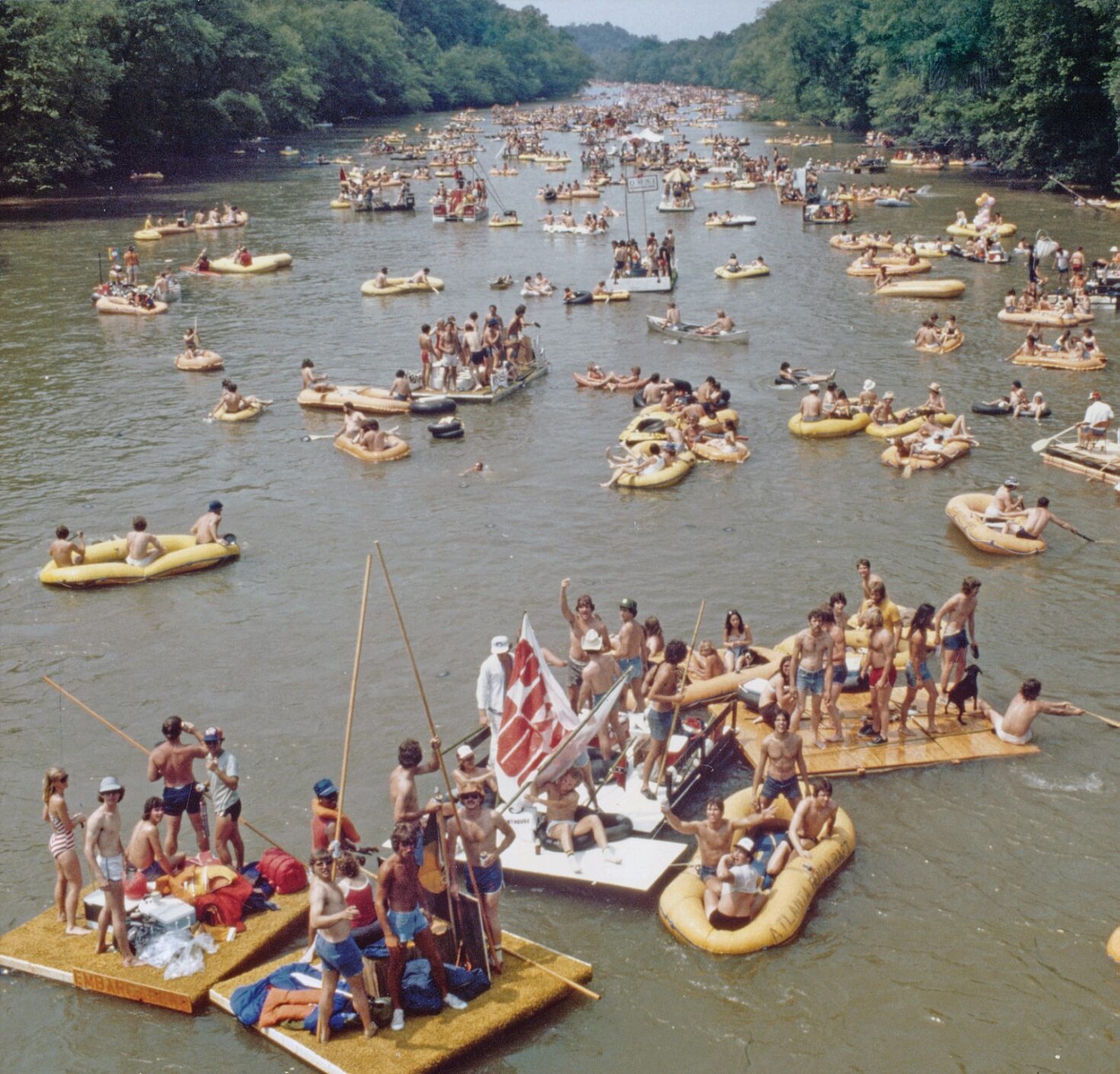
Full-Scale Fun
Each year after, the Ramblin’ Raft Race grew into an ever larger and grander spectacle. Hot-air balloons floated above the river. Anheuser-Busch became a major sponsor and sold more beer at the race than at any other event it underwrote at the time. Concerts by Charlie Daniels and Mother’s Finest drew in larger crowds. Playboy’s 25th Anniversary playmate Candy Loving attracted a crowd of her own when she attended the race. Several couples even got married on the river during the race.
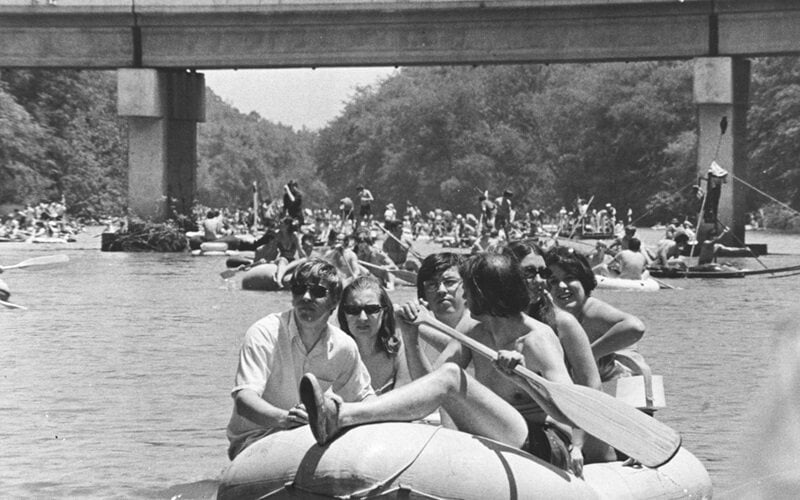 National media outlets from Sports Illustrated to CBS News covered the event. The race was memorialized in the movie The Great American Raft Race! It even had its own song. “The Ballad of the Chattahoochee Ramblin’ Raft Race,” written by the ARA’s promotions and campaign manager Tom Freeman, catalogued some of the creative crafts on the water:
National media outlets from Sports Illustrated to CBS News covered the event. The race was memorialized in the movie The Great American Raft Race! It even had its own song. “The Ballad of the Chattahoochee Ramblin’ Raft Race,” written by the ARA’s promotions and campaign manager Tom Freeman, catalogued some of the creative crafts on the water:
beds and cots all floatin’ like yachts/rafts with rails and bedsheet sails/ pontoons, rowboats, sternwheel paddlers/ Viking, slowboats, bicycle straddlers.
There were even crazier entries in the race’s armada over the years: a full-sized replica of a 53-foot tractor trailer, an airplane, Luke Skywalker’s cruiser from Star Wars, the Monitor and Merrimack Civil War battleships. There were floating pianos, Volkswagens, tropical islands, bathtubs, coffins, even a Jaws-inspired shark. And in between them, “enough inner tubes lashed together to supply every citizen in Atlanta with a new tube,” says Gil Patrick.
Through the ARA, the Patrick brothers and several paid crew members took the raft race concept on the road to nearly a dozen cities, ranging from Tampa to Washington, D.C., to New Orleans. Knaszak earned three years of co-op credit for that work and was one of several ARA team members bestowed the designation of “Kentucky Colonel” from the Bluegrass State’s governor for their work on the Louisville race. “There was tremendous camaraderie working on the races,” Knaszak says. “And I learned a lot of business skills that an engineering student wouldn’t necessarily have gotten at Tech.”
In 1978, when President Jimmy Carter created the Chattahoochee River National Recreation Area, “Larry was elated,” says Gil Patrick. “This was a goal he had been diligently working and campaigning for. With the national attention of the race and people experiencing and seeing the beauty of the river, it became personal to them. It helped save the river from urban development.”
An Enduring Legacy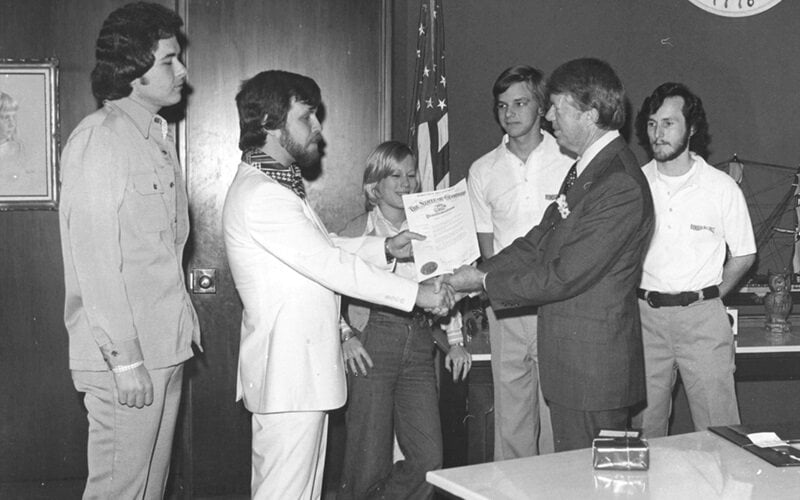
1979 was truly the peak of the Ramblin’ Raft Race. Following a struggle between ARA and WQXI, the station took over the event in 1980, which was the race’s final year.
Yet the legacy of the Ramblin’ Raft Race lives on. The race put the Chattahoochee on the map as a recreation destination. In 2021, for example, more than 3.2 million people visited the Chattahoochee River National Recreation Area. Alumni from the race era cherish their memories of a rollicking and carefree day prior to finals spent on the river with friends, enjoying “a beautiful day in a beautiful place,” as the lyrics of the race ballad recall. “The joy that it brought to people was incredible,” Knaszak says.
As for the leaders and volunteers, they still feel a tremendous sense of pride and amazement in pulling off such a monumental cultural phenomenon. “The organizers of Woodstock only managed to do it once,” says Gil Patrick. “We did it every year.”
Ramblin’ Raft Race Memories
An iconic chapter of Atlanta history, the Ramblin’ Raft Race attracted hundreds of thousands of spectators at its peak in the 1970s. We asked you to tell us your stories about the Ramblin’ Raft Race or shooting the Hooch with friends.
Ron Edwards, IM 70 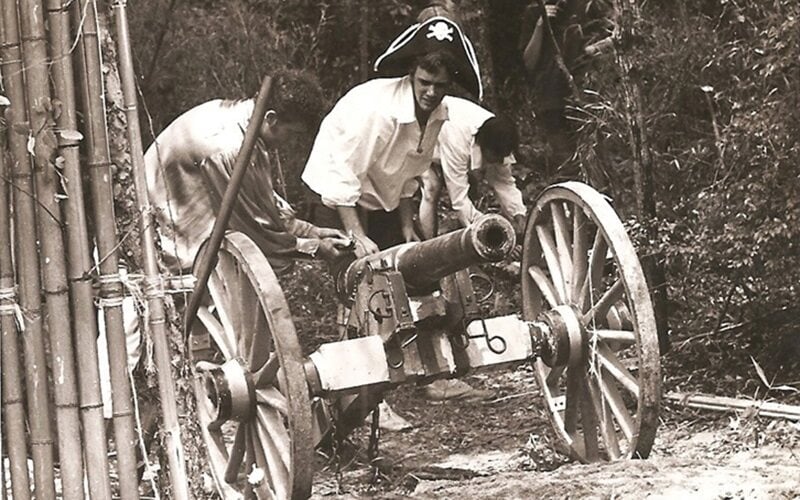 “Larry Patrick was an innovative character in every respect. He led a group of brothers into building a cannon that would be positioned on a bluff overlooking the river. But Larry did not stop there. He made contact with a Confederate civil war reenactor group in Marrietta and talked them into loaning the fraternity a light cannon. Three brothers: Ron Edwards, Bob Reiger, and Brad Childs, decked out in pirate costume, formed the crew for the civil war cannon and received "training" on how to fire the cannon without suffering bodily injury. To that point, no one lost an eye or a hand, but our ears were still ringing the next day. As the raft race got underway, we charged our cannon with a quarter of a pound of black power and packed it in with a wade of Constitution-Journal newspaper. As rafters came around a bend in the river about a mile from the starting line, we blasted them with great enthusiasm from the bluff with the fraternity-made cannon and the opposite side of the river with the Confederate gun. The blast echoed across the Chattahoochee and sent a shower of confetti onto the water. The civil war cannon was 150 yards or so from the rafters, so they were in no real danger, but did feel and recoil from the concussion from the cannon's blast. Disney's "Pirates of the Caribbean" certainly had nothing on the Delt Sig pirates! Now, when you get three students from an engineering school together, someone is bound to come up with an idea on how to make the blast "louder and stronger." And that idea was to charge the cannon with just a bit more powder (louder), pack it down with newspaper as per standard, but then add a softball-size wet wade of newspaper to the load (stronger) to capture and compress the sound. As the next group of rafting victims rounded the bend, we fired ‘ol' Betsy’. The roar of the cannon was indeed louder, and its concussion resonated strongly across the waters. But most surprising and terrifying to both cannon crew and rafters was the sight of an approximately 2-pound wad of paper flying across the river at great speed and impacting the far side bank. The cannon crew had just created the greatest "spitball" of all times. Needless to say, the cannon crew was shaken into the realization of what could have happened and how fortunate they were that they had not aimed with any precision. There was unanimous concurrence among the crew to not repeat the big-bang experiment but confine the cannon to its confetti role.”
“Larry Patrick was an innovative character in every respect. He led a group of brothers into building a cannon that would be positioned on a bluff overlooking the river. But Larry did not stop there. He made contact with a Confederate civil war reenactor group in Marrietta and talked them into loaning the fraternity a light cannon. Three brothers: Ron Edwards, Bob Reiger, and Brad Childs, decked out in pirate costume, formed the crew for the civil war cannon and received "training" on how to fire the cannon without suffering bodily injury. To that point, no one lost an eye or a hand, but our ears were still ringing the next day. As the raft race got underway, we charged our cannon with a quarter of a pound of black power and packed it in with a wade of Constitution-Journal newspaper. As rafters came around a bend in the river about a mile from the starting line, we blasted them with great enthusiasm from the bluff with the fraternity-made cannon and the opposite side of the river with the Confederate gun. The blast echoed across the Chattahoochee and sent a shower of confetti onto the water. The civil war cannon was 150 yards or so from the rafters, so they were in no real danger, but did feel and recoil from the concussion from the cannon's blast. Disney's "Pirates of the Caribbean" certainly had nothing on the Delt Sig pirates! Now, when you get three students from an engineering school together, someone is bound to come up with an idea on how to make the blast "louder and stronger." And that idea was to charge the cannon with just a bit more powder (louder), pack it down with newspaper as per standard, but then add a softball-size wet wade of newspaper to the load (stronger) to capture and compress the sound. As the next group of rafting victims rounded the bend, we fired ‘ol' Betsy’. The roar of the cannon was indeed louder, and its concussion resonated strongly across the waters. But most surprising and terrifying to both cannon crew and rafters was the sight of an approximately 2-pound wad of paper flying across the river at great speed and impacting the far side bank. The cannon crew had just created the greatest "spitball" of all times. Needless to say, the cannon crew was shaken into the realization of what could have happened and how fortunate they were that they had not aimed with any precision. There was unanimous concurrence among the crew to not repeat the big-bang experiment but confine the cannon to its confetti role.”
David Turk, IE 77
Member of the Army ROTC team (Ranger). Short of it, we raced other units in a combat engineer boat (don’t remember how we did), but we were hitting the paddles hard through the entire course. After a short rest, we pulled rafts and their occupants out of the water at the finish line for the next 2-3 hours. Suffice it to say, most of the occupants were harder to remove than the rafts they were on.
Malcolm Marsh, ME 84
I built a “raft” from Styrofoam blocks, plywood, and nylon rope. It did slow 360s down the river until it came apart 3/4 of the way down. We abandoned ship to another vessel...exchanging beer and schnapps for a ride! It was chaotic fun. I recall a huge net across the river at the finish line…massive flotsam of the race was piled against it. Floats, coolers, inner tubes, etc.
Sam Hart, MS NE 85
Too many to recount.
Beth Sisson, ID 93
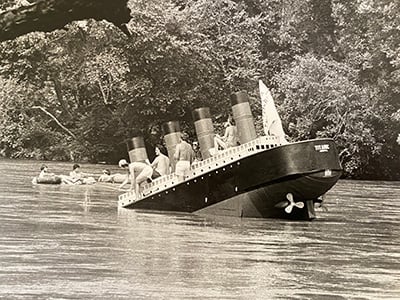 My father and his co-workers built some amazing “rafts” for the Ramblin’ Raft Race! I attended as a child the last two years to cheer him on. He was not a GT alum, but I think part of why he was so proud that I chose to attend Georgia Tech was his love of design and engineering. His team built crazy rafts including a submarine, Red Barron type “airplane”, a pirate ship, and even the Titanic, built to look like it was sinking. True to its name, the Chattahoochee Titanic sank after it hit a bridge on her maiden voyage in 1980. My father talked about the fun he had participating in the raft race all through his life. I found a retro Raft Race t-shirt to give him as a gift a few years before he passed away, and he had the biggest smile wearing it!
My father and his co-workers built some amazing “rafts” for the Ramblin’ Raft Race! I attended as a child the last two years to cheer him on. He was not a GT alum, but I think part of why he was so proud that I chose to attend Georgia Tech was his love of design and engineering. His team built crazy rafts including a submarine, Red Barron type “airplane”, a pirate ship, and even the Titanic, built to look like it was sinking. True to its name, the Chattahoochee Titanic sank after it hit a bridge on her maiden voyage in 1980. My father talked about the fun he had participating in the raft race all through his life. I found a retro Raft Race t-shirt to give him as a gift a few years before he passed away, and he had the biggest smile wearing it!
Glenn Brown, MgtSci 76
As a member of the Pi Kappa Alpha fraternity, we helped organize and support the craziness that went on in the night before the race, as well as all day with the race. Lotta fun, laughter, music, beer, mud, and hard work.
Carey Fisher
Wow.
Jim Brown
I was in the GT Army ROTC Ranger group, so we raced an 8-man Army raft down the Hooch.
Paul Hoffman, CE 82
In 1980 it was quite a crazy affair. Way too much alcohol and way too many rednecks. Bello Georgia Tech like Dave Lapin, and Kevin Dillon muscle our way through the crowd and the race. I think I saw five fistfights that day. But when you’re 20 years old, it was insane.
Sheldon Simon, Arch 75
Our raft was floating down the river without anyone on it. I had to shimmy across the starting cable to catch our raft before it floated down the hooch.
Drew Cooper, IM 79
Lived at Eastgate dorms that Larry owned just outside the tunnel. Got the opportunity to work with Larry and Gil at the finish line pulling people out of the water. Really great time with both of them. Also a great time setting up for Mother’s Finest.
J. Collier Mullins, BC 75
I loved the article in the Alumni Spring magazine on the Ramblin’ Raft Race. That brought back a LOT of memories. I started going to parties (and rafting trips) at Delta Sigma Phi in 1971, and I joined in 1972. I can remember many huge rafting expeditions while a Delta Sig at Tech. Our “house-mom” lived on the Chattahoochee River, a little down-river from the Hwy 41 exit point. She let us use her backyard as our exit point from the river. The late George Flowers and I continued the rafting fun after our graduation in 1975. I met my future (and current) wife Cindy on one of our Saturday rafting trips. Awesome fun and great memories…
Russell Smart, ChE 73
I did not participate in the first couple, but my roommates and I were on the river for the one in 1972 when the participation numbers exploded. We just floated in inner tubes and the water and air temps were very cold. We were very near hypothermia by the time we got to the end. I also seem to recall that it rained the night before and the put in parking area and the river takeout area were both extremely muddy with the amount of traffic. It was a mess, but we wanted to be there.
John Handy, IE 73
I just went along to watch (along with a bazillion others) and took photos.
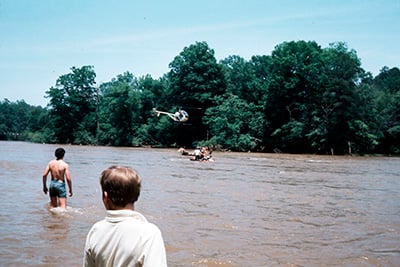 |
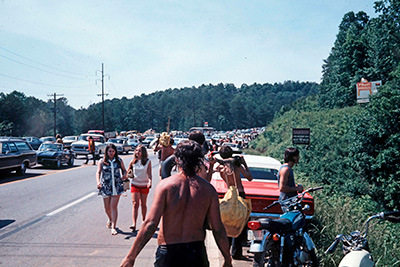 |
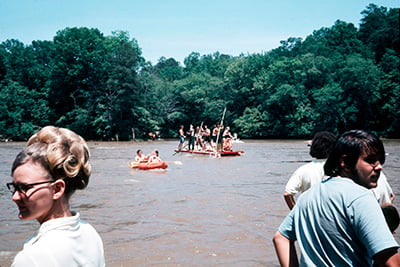 |
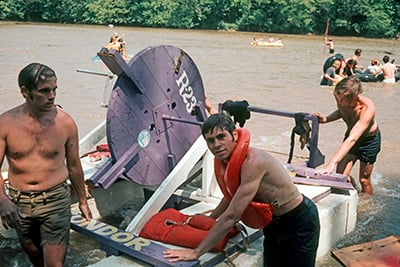 |
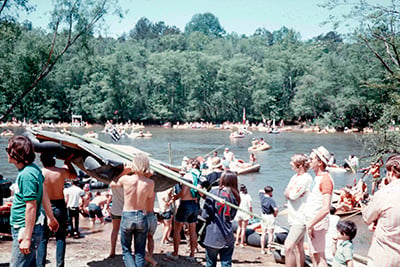 |
